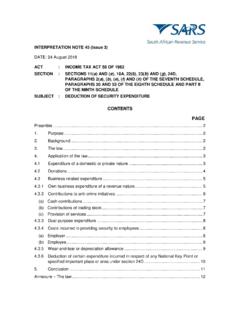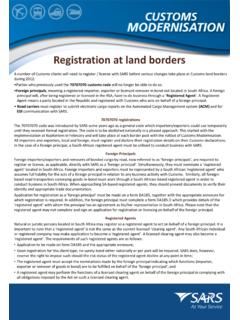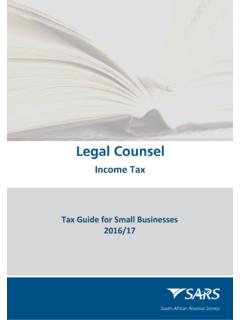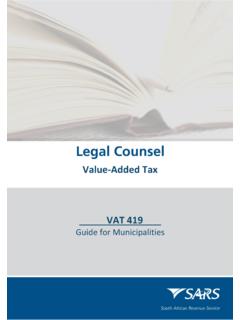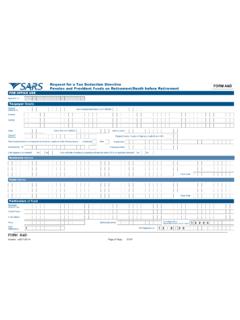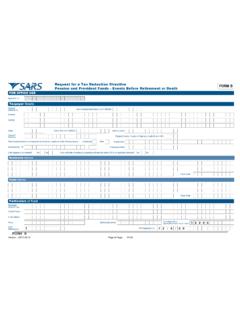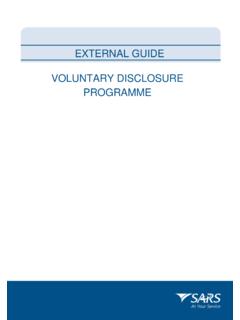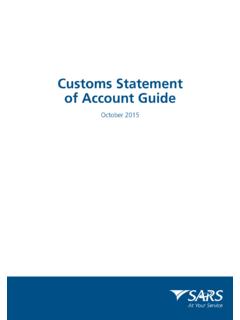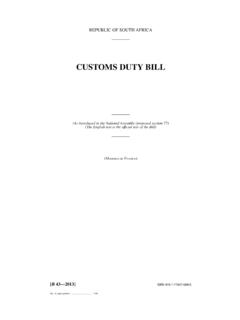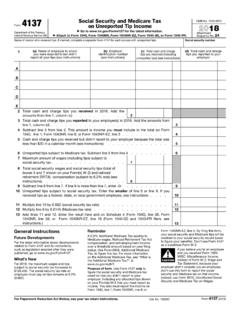Transcription of Introduction of Capital Gains Tax
1 ABC of Capital Gains Tax for Companies (Issue 9) 1 ABC of Capital Gains Tax for Companies Capital Gains Tax Issue 10 ABC of Capital Gains Tax for Companies (Issue 10) i ABC of Capital Gains Tax for Companies Preface This guide provides a basic Introduction to Capital Gains tax (CGT) for companies as defined in section 1(1) of the Income Tax 58 of 1962 (the Act) and should not be used as a legal reference. For more information about CGT you may visit the SARS website at ; visit your nearest SARS branch; contact your own tax advisor or tax practitioner; contact the SARS National Contact Centre if calling locally, on 0800 00 7277; if calling from abroad, on +27 11 602 2093 (only between 8h00 and 16h30 South African time); or consult the Comprehensive Guide to Capital Gains Tax or the Tax Guide for Share Owners, both of which are available on the SARS website.
2 SOUTH AFRICAN REVENUE SERVICE Date of 1st issue : October 2001 Date of 2nd issue : April 2002 Date of 3rd issue : January 2006 Date of 4th issue : 27 june 2008 Date of 5th issue : 5 April 2013 Date of 6th issue : 15 April 2015 Date of 7th issue : 10 February 2017 Date of 8th issue : 26 November 2018 Date of 9th issue : 11 March 2020 Date of 10th issue : 1 July 2021 ABC of Capital Gains Tax for Companies (Issue 10) ii Contents Preface .. i 1. Introduction .. 1 2. Overview of the core provisions of Capital Gains tax .. 1 3. Determining a Capital gain or Capital loss .. 3 Asset .. 3 Disposal .. 3 Proceeds .. 4 Base cost .. 4 4. Base cost of assets acquired before 1 October 2001 .. 6 20% of proceeds method .. 6 Market-value method .. 6 Time-apportionment base cost 8 5. Exclusions .. 11 6. Roll-over of Capital gain or Capital loss .. 12 7. Aggregate Capital gain or aggregate Capital loss .. 12 8. Net Capital gain or assessed Capital loss.
3 12 9. Inclusion rate and taxable Capital gain .. 12 10. Effective rates of Capital Gains tax .. 12 ABC of Capital Gains Tax for Companies (Issue 10) 1 1. Introduction Capital Gains tax (CGT) was introduced in South Africa with effect from 1 October 2001 and applies to the disposal of an asset on or after that date. South African residents are subject to CGT on the disposal of assets not only in South Africa, but anywhere in the world. All Capital Gains and Capital losses made on the disposal of assets are subject to CGT unless specifically excluded. Section 26A of the Act provides that the taxable Capital gain must be included in taxable income. CGT is therefore not a separate tax but forms part of income tax. The CGT provisions are mostly contained in the Eighth Schedule to the Act, although some are in the main body of the Act, such as those dealing with change of residence, ceasing to be a controlled foreign company or becoming a headquarter company (section 9H), government grants (section 12P), international shipping (section 12Q) and the corporate restructuring rules (sections 41 to 47).
4 2. Overview of the core provisions of Capital Gains tax The CGT Flowchart below sets out the core steps in determining a taxable Capital gain to be included in taxable income or an assessed Capital loss to be carried forward to a subsequent year of assessment. ABC of Capital Gains Tax for Companies (Issue 10) 2 .. to be included in .. calculated per individual asset section 26A Eighth Schedule Taxable Capital gain Net Capital gain Multiply by inclusion rate Assessed Capital loss Carried forward Capital gain Apply exclusions Apply roll-overs Capital loss Apply exclusions Apply limitations gross income exemptions income deductions taxable income rates of tax rebates income (normal) tax payable INCOME TAX ACT 58 of 1962 Attribution rules carried forward to next year of assessment deduct/add prior year s assessed Capital loss, as the case may be disposal (or deemed disposal) of asset proceeds (or deemed proceeds) deduct base cost aggregate Capital gain aggregate Capital loss sum of all Capital Gains and losses, reduced by annual exclusion (individuals/special trusts only) > R 0 or < R 0 ABC of Capital Gains Tax for Companies (Issue 10) 3 3.
5 Determining a Capital gain or Capital loss The Eighth Schedule contains four key definitions (Asset, Disposal, Proceeds and Base Cost) which form the basic building blocks in determining a Capital gain or Capital loss. A person s Capital gain on disposal of an asset is the amount by which the proceeds exceed the base cost of that asset. A Capital loss is equal to the amount by which the base cost of the asset exceeds the proceeds. Example 1 Determination of a Capital gain or Capital loss Gain Loss R R Proceeds 10 000 Proceeds 10 000 Less: Base cost (5 000) Less: Base cost (20 000) Capital gain 5 000 Capital loss (10 000) Asset An asset is widely defined and includes property of whatever nature, whether movable or immovable, corporeal or incorporeal and any right to, or interest in, such property. Any currency is excluded from the definition of asset , but any coin made mainly from gold or platinum is included.
6 CGT applies to all assets disposed of on or after 1 October 2001 (valuation date), regardless of whether the asset was acquired before, on, or after that date. Nevertheless, only the Capital gain or Capital loss attributable to the period on or after 1 October 2001 must be brought to account for CGT purposes. Disposal A wide meaning is given to the term disposal . The Eighth Schedule provides for both disposals and deemed disposals. A disposal covers any event, act, forbearance or operation of law which results in the creation, variation, transfer or extinction of an asset or any event, act, forbearance or operation of law which is under the Act treated as the disposal of an asset. The following are some examples of events that are disposals or that are treated as disposals: Sale of an asset Donation of an asset Expropriation of an asset Loss or destruction of an asset Change in the use of an asset A company ceasing to be a controlled foreign company A person ceasing to be a resident A company becoming a headquarter company ABC of Capital Gains Tax for Companies (Issue 10) 4 The following are some examples of events that are not regarded as disposals: The transfer of an asset as security for a debt and the transfer of such asset back to the debtor upon the release of the security.
7 The issue, cancellation or extinction of a share by a company. In the hands of the shareholder, however, a share-buy-back by a company constitutes a disposal. The issue of any debt by or to a person. The subdivision, consolidation or conversion of shares when the shareholder receives only replacement shares so that the participation rights and the interest of the person in the company remain unaltered. The Eighth Schedule provides for situations when only a part of an asset is disposed of, for example, sub-division or disposal of part of land. In such a case only part of the base cost of the asset can be deducted from the proceeds derived from the part disposed of. It is important to note that the Eighth Schedule specifies the time of disposal of an asset. For different types of disposal the timing of the disposal may be different. For example, when an asset is disposed of under an agreement which is subject to a suspensive condition, the time of disposal is when the condition is satisfied.
8 When the agreement is not subject to a suspensive condition, the time of disposal is when the agreement is concluded. The time of disposal is important, since it determines when the Capital gain or Capital loss must be accounted for. Proceeds The amount received by or accrued to the seller on disposal of an asset or any amount that is treated as having been received by or accrued to the taxpayer (deemed disposal) constitutes the proceeds. Assets disposed of by donation, for a consideration not measurable in money, or to a connected person at a non-arm s-length price are treated as being disposed of for an amount received or accrued equal to the market value of the asset. Proceeds will also be treated as being at market value when specified deemed disposal events occur, such as ceasing to be a resident; a company ceasing to be a controlled foreign company; a company becoming a headquarter company; the conversion of a Capital asset to trading stock; and the distribution of an asset in specie.
9 Amounts included in income or gross income such as a recoupment of Capital allowances or dividends constituting a share buy-back are excluded from proceeds. Base cost Broadly the determination of the base cost of an asset depends on whether the asset was acquired before 1 October 2001; on or after 1 October 2001; ABC of Capital Gains Tax for Companies (Issue 10) 5 by donation, for a consideration not measurable in money or from a connected person at a non-arm s length price; or in consequence of a deemed disposal event such as a distribution in specie, ceasing to be a resident, a company ceasing to be a controlled foreign company, a company becoming a headquarter company or the conversion of a Capital asset to trading stock. The assets described in the last two bullet points above are generally treated as having been acquired at a cost equal to their market value. Assets acquired on or after 1 October 2001 The base cost of an asset acquired on or after 1 October 2001 generally comprises the actual expenditure incurred on the asset.
10 In order to qualify for inclusion in base cost, such expenditure must qualify under paragraph 20 of the Eighth Schedule. Some of the main costs that qualify to be part of the base cost of an asset include the costs of acquisition or creation of the asset; the cost of valuing the asset for the purpose of determining a Capital gain or Capital loss; the following amounts actually incurred as expenditure directly related to the acquisition or disposal of the asset, namely the remuneration of a surveyor, valuer, auctioneer, accountant, broker, agent, consultant or legal advisor, for services rendered; transfer costs; securities transfer tax, transfer duty or similar tax or duty; advertising costs to find a seller or to find a buyer; the cost of moving the asset from one location to another; installation costs including foundations and supporting structures; donations tax limited by a formula; cost of an option used to acquire or dispose of the asset.
